The AMD Ryzen 5 2500X and Ryzen 3 2300X CPU Review
by Ian Cutress on February 11, 2019 11:45 AM ESTCPU Performance: Web and Legacy Tests
While more the focus of low-end and small form factor systems, web-based benchmarks are notoriously difficult to standardize. Modern web browsers are frequently updated, with no recourse to disable those updates, and as such there is difficulty in keeping a common platform. The fast paced nature of browser development means that version numbers (and performance) can change from week to week. Despite this, web tests are often a good measure of user experience: a lot of what most office work is today revolves around web applications, particularly email and office apps, but also interfaces and development environments. Our web tests include some of the industry standard tests, as well as a few popular but older tests.
We have also included our legacy benchmarks in this section, representing a stack of older code for popular benchmarks.
All of our benchmark results can also be found in our benchmark engine, Bench.
WebXPRT 3: Modern Real-World Web Tasks, including AI
The company behind the XPRT test suites, Principled Technologies, has recently released the latest web-test, and rather than attach a year to the name have just called it ‘3’. This latest test (as we started the suite) has built upon and developed the ethos of previous tests: user interaction, office compute, graph generation, list sorting, HTML5, image manipulation, and even goes as far as some AI testing.
For our benchmark, we run the standard test which goes through the benchmark list seven times and provides a final result. We run this standard test four times, and take an average.
Users can access the WebXPRT test at http://principledtechnologies.com/benchmarkxprt/webxprt/

WebXPRT 2015: HTML5 and Javascript Web UX Testing
The older version of WebXPRT is the 2015 edition, which focuses on a slightly different set of web technologies and frameworks that are in use today. This is still a relevant test, especially for users interacting with not-the-latest web applications in the market, of which there are a lot. Web framework development is often very quick but with high turnover, meaning that frameworks are quickly developed, built-upon, used, and then developers move on to the next, and adjusting an application to a new framework is a difficult arduous task, especially with rapid development cycles. This leaves a lot of applications as ‘fixed-in-time’, and relevant to user experience for many years.
Similar to WebXPRT3, the main benchmark is a sectional run repeated seven times, with a final score. We repeat the whole thing four times, and average those final scores.
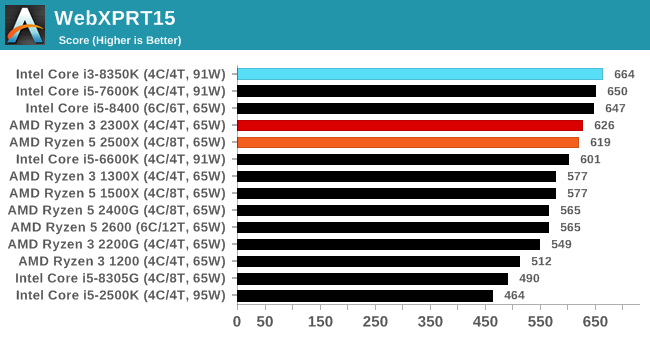
Speedometer 2: JavaScript Frameworks
Our newest web test is Speedometer 2, which is a accrued test over a series of javascript frameworks to do three simple things: built a list, enable each item in the list, and remove the list. All the frameworks implement the same visual cues, but obviously apply them from different coding angles.
Our test goes through the list of frameworks, and produces a final score indicative of ‘rpm’, one of the benchmarks internal metrics. We report this final score.
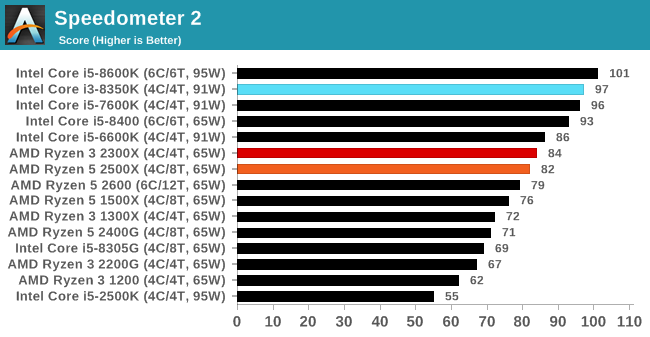
Google Octane 2.0: Core Web Compute
A popular web test for several years, but now no longer being updated, is Octane, developed by Google. Version 2.0 of the test performs the best part of two-dozen compute related tasks, such as regular expressions, cryptography, ray tracing, emulation, and Navier-Stokes physics calculations.
The test gives each sub-test a score and produces a geometric mean of the set as a final result. We run the full benchmark four times, and average the final results.
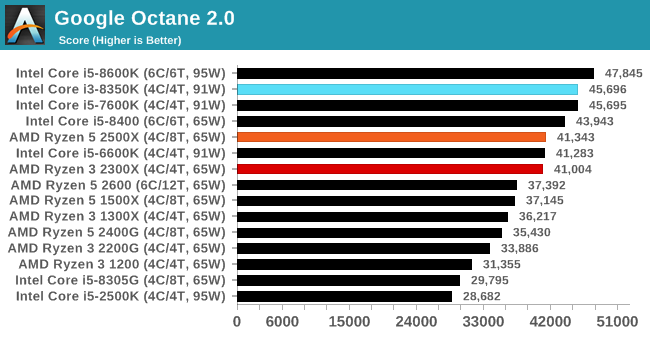
Mozilla Kraken 1.1: Core Web Compute
Even older than Octane is Kraken, this time developed by Mozilla. This is an older test that does similar computational mechanics, such as audio processing or image filtering. Kraken seems to produce a highly variable result depending on the browser version, as it is a test that is keenly optimized for.
The main benchmark runs through each of the sub-tests ten times and produces an average time to completion for each loop, given in milliseconds. We run the full benchmark four times and take an average of the time taken.
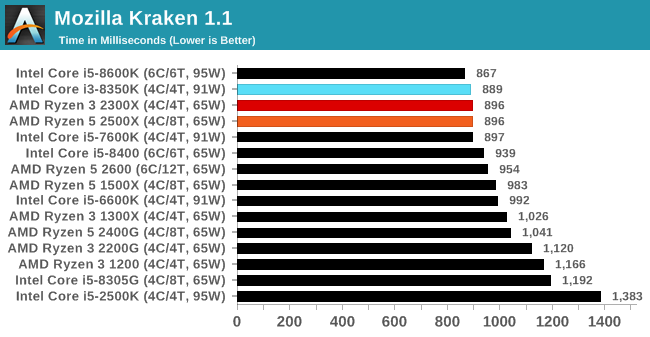
3DPM v1: Naïve Code Variant of 3DPM v2.1
The first legacy test in the suite is the first version of our 3DPM benchmark. This is the ultimate naïve version of the code, as if it was written by scientist with no knowledge of how computer hardware, compilers, or optimization works (which in fact, it was at the start). This represents a large body of scientific simulation out in the wild, where getting the answer is more important than it being fast (getting a result in 4 days is acceptable if it’s correct, rather than sending someone away for a year to learn to code and getting the result in 5 minutes).
In this version, the only real optimization was in the compiler flags (-O2, -fp:fast), compiling it in release mode, and enabling OpenMP in the main compute loops. The loops were not configured for function size, and one of the key slowdowns is false sharing in the cache. It also has long dependency chains based on the random number generation, which leads to relatively poor performance on specific compute microarchitectures.
3DPM v1 can be downloaded with our 3DPM v2 code here: 3DPMv2.1.rar (13.0 MB)
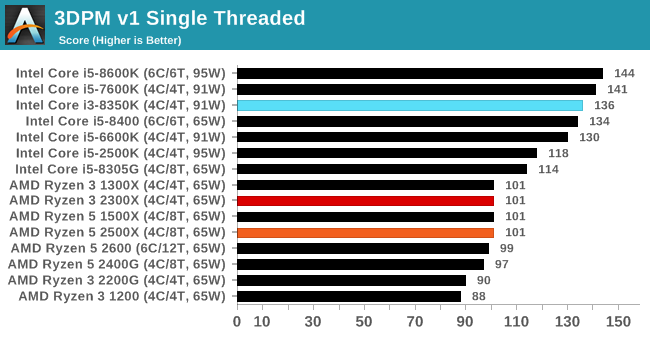
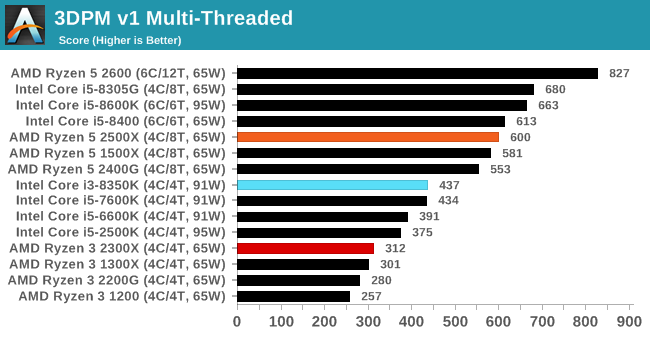
x264 HD 3.0: Older Transcode Test
This transcoding test is super old, and was used by Anand back in the day of Pentium 4 and Athlon II processors. Here a standardized 720p video is transcoded with a two-pass conversion, with the benchmark showing the frames-per-second of each pass. This benchmark is single-threaded, and between some micro-architectures we seem to actually hit an instructions-per-clock wall.

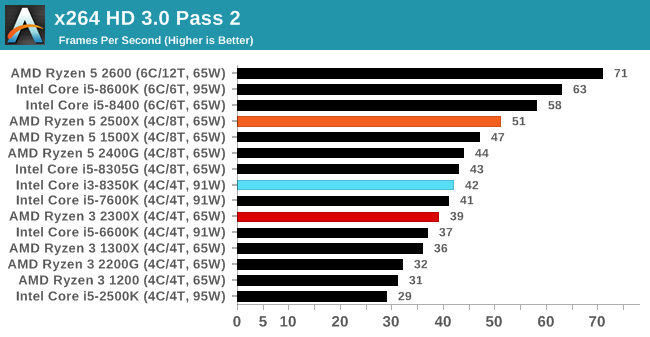










65 Comments
View All Comments
romrunning - Monday, February 11, 2019 - link
It may just be me, but all of the links on the "Pages In This Review" at the bottom of the main page simply return me to the main page.romrunning - Monday, February 11, 2019 - link
But the drop-down to the specific page works as expected.evilspoons - Monday, February 11, 2019 - link
It's definitely not just you. I spent a few tries wondering what I was doing wrong and re-read the start of the article until I tried the drop-down menu instead of the links.Ian Cutress - Monday, February 11, 2019 - link
That's my fault, as the hyperlinks need to be manually added. I had messed up the part of the URL after the /show/13945. It should be fixed now.Kevin G - Monday, February 11, 2019 - link
I noticed this as well.IGTrading - Monday, February 11, 2019 - link
Thank you Ian for a good review.I completely agree with the conclusion that the 2300X makes perfect sense, but the 2500X is harder to place in the picture ...
On the other hand, despite 2400G and the 2500X have the same TDP, if I look at the graph with full load power consumption, I can clearly see that the latter has a very generous thermal limit, compared with the 2400G where the thermal envelope seems to be very strictly limited.
Meaning OEMs will probably be able to use the 2500X for cheaper gaming systems where auto-overclocking is used as a feature and AMD will thus be able to offer something better for a lower price.
This also allows AMD to push AM4 harder on the market, giving itself the opportunity to future upgrades for AM4 buyers.
So the 2500X will show considerably better performance than the 2400G despite the similar config (minus the iGPU) while not cannibalizing the 2600 nor the 2400G.
If AMD manages to sell more 2500X through OEMs, AMD also builds a future upgrade market for itself, unlike Intel that will likely push buyers into purchasing new machines.
dromoxen - Monday, February 11, 2019 - link
ppl buying these CPUs are not the sort to be upgrading the CPU.. to most the computer is a closed box and is upgraded as a whole . I do wonder where all these cores are going .. I mean its great to have 4 6 8 cores with another 8 hyperthreads .. but who is using all that power ? Lets make 4 cores the absolute limit , unless you have a Govt permit to purchase more.GreenReaper - Monday, February 11, 2019 - link
Browsers have been getting a lot better at using multiple cores, and websites surely do enough in the background nowadays to justify the effort.RadiclDreamer - Tuesday, February 12, 2019 - link
Why would there be any limit on how man cores? Whats it to you that I want to transcode movies faster, or multitask more, or anything else? And government permit to have more? Thats just insane.kaidenshi - Tuesday, February 12, 2019 - link
He's trolling like he always does. Anything to get under someone's skin enough to get a reaction out of them.